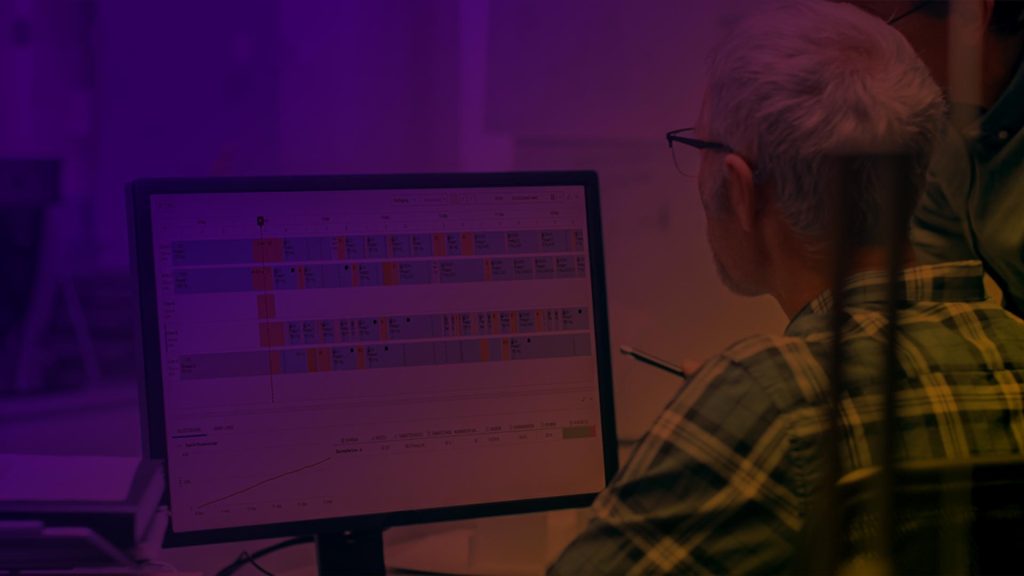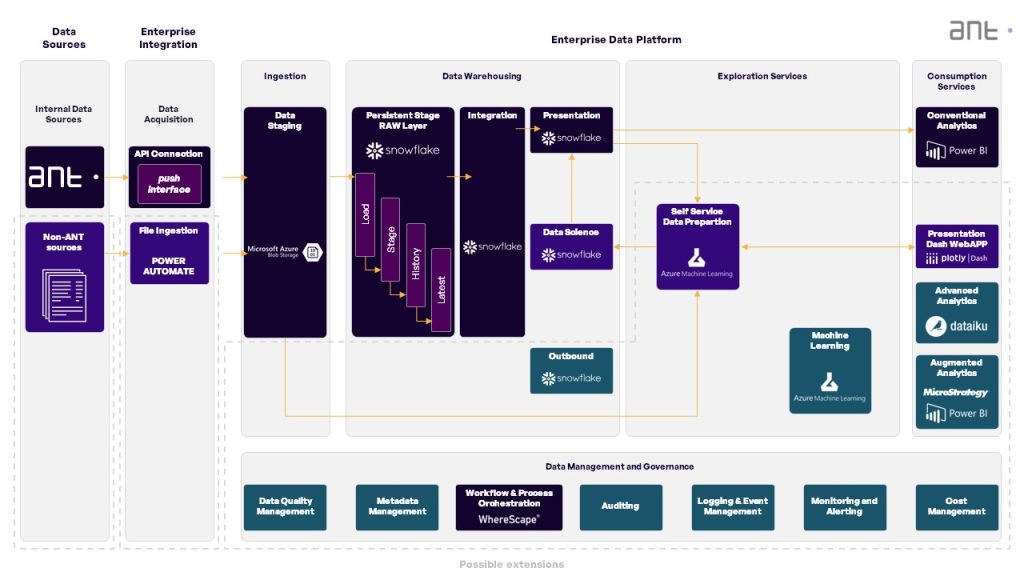Cloud manufacturing
One secure location for all your production data
What is Cloud Manufacturing?
Cloud manufacturing is the application of cloud computing in manufacturing. It enables manufacturers to connect, share, and manage data and resources using the Internet. The concept of cloud manufacturing was proposed as a way to apply cloud computing to the global manufacturing industry. It can improve manufacturing efficiency and flexibility, and reduce costs.
Cloud MES is driving new opportunities:
- Horizontal integration of suppliers across the value chain
- Cloud-based MES solutions can help to improve horizontal integration across the supply chain. This is because cloud-based solutions can provide visibility into the manufacturing process from end to end. This visibility can help to identify bottlenecks and optimize the manufacturing process.
- Tracking carbon emissions
- Cloud-based MES solutions can help factories track their carbon emissions. By tracking production data, such as energy use, in the cloud, factories can identify opportunities to reduce their emissions. Additionally, cloud-based MES solutions can help factories track their progress towards emissions reduction goals.
- Seamless mergers and acquisitions
- Cloud-based MES solutions can help factories seamlessly merge with or acquire other factories. By tracking production data in the cloud, factories can easily share data between factories. Additionally, cloud-based MES solutions can help factories keep track of production schedules and recipes, making it easy to transition to a new factory.
- Dynamic production scheduling
- Cloud-based MES solutions can help factories dynamically schedule production. By tracking production data in the cloud, factories can quickly identify changes in demand and adjust production accordingly. Additionally, cloud-based MES solutions can help factories automatically generate production schedules based on customer orders.
- Development of new services
- Cloud-based MES solutions can help factories develop new services. By tracking production data in the cloud, factories can quickly identify opportunities to develop new requirements for services which can improve their production. Additionally, cloud-based MES solutions can help factories track customer demand for new services.
Cloud solution architecture - what does it look like?
A cloud-based MES solution typically includes a web-based user interface, a database, and application servers. The web-based user interface provides users with access to the MES solution from any location with an internet connection. The database stores data about the manufacturing process, such as recipes, production schedules, and product data. The application servers host the MES software and provide the processing power for the solution.

Cloud-based MES, hybrid or on-premise, what are the differences?
Cloud-based MES or on-premise, what are the differences?
There are many differences between on-premise and cloud-based MES solutions. One of the biggest differences is that on-premise solutions are typically more expensive to implement and maintain than cloud-based solutions. On-premise solutions also require more IT infrastructure and support than cloud-based solutions. Cloud-based solutions are typically easier to implement and require less IT support. Another difference is that on-premise solutions are usually more customizable than cloud-based solutions. On-premise solutions can also be more difficult to upgrade than cloud-based solutions.
Which is better for your business?
The best answer for this question depends on the specific needs of your business. If you have a large budget and the need for a lot of customization, an on-premise MES solution may be a better option. If you have limited resources and the need for a less complex solution, a cloud-based MES solution may be a better option.
What about hybrid MES architecture?
A cloud hybrid model architecture is a combination of on-premises, private cloud, and public cloud services. This type of architecture allows organizations to use a mix of different cloud deployment models to optimize their operations and meet their specific business needs. With a cloud hybrid model, organizations can keep some data and applications on-premises for security and compliance reasons, while also leveraging the benefits of the public cloud, such as scalability and flexibility. This approach allows organizations to take advantage of the best of both worlds and create a more flexible and scalable IT environment.
MES functionality is increasingly moving to the cloud. ~46% of manufacturers have or are considering cloud MESAccording to a 2018 AWS / IDC survey of German and American MES users
Cloud in a production environment
What are the benefits and drawbacks?
Cloud-based MES solutions have many benefits, including lower upfront costs, lower IT support costs, and easier implementation. However, cloud-based solutions can be less customizable than on-premise solutions and may be more difficult to upgrade. Find out what solution suits your business best by contacting us today.
Benefits
-
Scalability
Ability to connect an unlimited number of production lines, equipment and factories - new resources on demand - alleviating growing resource demands -
Accessibility
Easy access to real-time operational data at any time from any place. Operators can access applications from any production facility, factory management from anywhere -
Agility and Flexibility
Agile adaptable resource allocation when it comes to increasing or decreasing the size of operations. This is important when production ramps up and MES must be scaled quickly and easily -
Better Use of IT Resources
Easy to deploy, requiring no hardware or network infrastructure and no engagement of IT teams. Once deployed, MES doesn’t require costly upgrades, server maintenance, or frequent oversight -
Additional Cloud Services
There are a variety of different Cloud services, which can be used as an extension to MES System – BI, AI, and Reporting. Adding new services is just a configuration effort -
Improved Security
Standard high-level security, with software maintenance and security being updated by the Cloud provider. However, with an on-premises MES, security is expensive and requires regular updates -
High Availability
Possibility to increase availability and redundancy without significant investment costs
Drawbacks
-
Hight latency
Companies considering cloud MES have to check location of cloud server country or region to factory. network connection between MES server and your factory. Finally, the amount of data being transferred between your MES. In case of lost connection, internal buffer has to be installed to store production data -
Limited Flexibility
While cloud MES has a lot of benefits, one of the drawbacks is that it can be less flexible than on-premise MES. This is because cloud MES is typically delivered as a software-as-a-service (SaaS) solution, which means that it has limited customization options. If you need a MES solution that is highly customizable, an on-premise solution may be a better option -
Disputable Data Ownership
One of the potential drawbacks of cloud-based MES solutions is that the data generated by the MES solution may be owned by the MES provider. This can be a problem if you want to switch MES providers or if you want to keep the data for internal purposes. Make sure to check with the MES provider to see who owns the data before choosing a solution -
Possible Higher Cost
Cloud-based MES solutions may quickly become more expensive than on-premise solutions. This is because cloud-based solutions typically are priced by data usage and processing power which counts in virtual infrastructure and support. If you are considering a cloud-based MES solution, be sure to get a customized quote to determine the true cost of the solution in different circumstances
Cloud means a new approach to development – DevOps
Cloud-based MES solutions require a new approach to development, called DevOps. DevOps is a set of practices that combines software development and IT operations to deliver applications and services faster. DevOps is essential for cloud-based MES solutions because of the need to rapidly develop and deploy new features and updates.
Cloud means new methodology – DevOps approach:
- Adopt cloud-native tools and practices
- Managed services over self-maintenance
- Re-architect toward adoption of new concepts
- Achieve self-healing capabilities
- SDLC (Software Development Life Cycle) for managing different environments and automating migration between environment
The goal for using the new methodology is:
- Automation of deployment and quality assurance (Automated upgrades and installation process)
- CI/CD – continuous integration and delivery
- Automated provisioning of infrastructure and its scalability (IaaS)
- Usage of cloud-native tools for performance monitoring, logging, security, code scanning, audits, etc.
- Automated testing (unit and end-2-end) as part of SDLC
Security of production data in the cloud - what to pay attention to?
One of the biggest concerns with cloud-based MES solutions is the security of production data. Production data is often sensitive and confidential, so it is important to choose a MES solution that has strong security features. Look for a solution that offers user authentication, data encryption, and access control.

Modern approach to SLA – split of responsibility:
Responsibilities:
- The cloud service provider takes responsibility for everything that is happening in the Cloud.
- The customer is responsible for providing internet service and performing maintenance tasks on connectivity infrastructure and Edge devices.
Disaster Recovery:
- All data is periodically backup up in the Cloud using Recovery Services.
- Data redundancy should be set on Zone level which prevents loss of any data at twelve nines, but backups are still performed to have a way to recover from ANT data corruption or deletion caused by a bug or other destructive behaviors of the systems and its users.
- The server itself should be automatically recreated on another Node when the cluster self-heals. In an extreme case of cluster failure, a new cluster from CI/CD should be created and the service will be deployed.
Cloud solutions in the factory - how much does it cost?
The cost of a cloud-based MES solution depends on many factors, such as the number of users, the number of production lines, and the level of customization. Contact us today to get a customized quote for your business.

Thanks to our solution called “push interface,” we are able to transfer data from the MES ANT system to a ready-made data warehouse or create one for the client themselves. This enables analysts in a manufacturing company to synthesize and retrieve data from multiple sources into PowerBI and create custom charts for analyzing the factory’s situation. For example, an overview of the factory, start analysis, MTBF analysis, quality analysis, or waste analysis. ANT has the capability to integrate with multiple database solution providers such as Azure Synapse or Snowflake for data processing and analysis in the cloud. Snowflake can be configured on any cloud infrastructure.
The process we utilize is ETL: Push (Extract) -> Store Raw Data (Transform) -> Apply to Data Warehouse (Load).
Use data from multiple sources with PowerBi
Get Cloud MES For Your Factory with ANT
ANT is a leading provider of cloud-based MES solutions. Our solutions are designed to help manufacturers optimize their production processes and improve their bottom line. Contact us today to learn more about our solutions and get a free demo.
Sign up to our newsletter
Related Products

Energy Management System (EMS)
Energy Management System (EMS) Monitor utilities usage in real-time and reduce cost Schedule a Demo They Trusted Us: What is ANT EMS? ANT Energy Management

MES System – Manufacturing Execution System – ANT Solutions
System MES – Manufacturing Execution System 0 % operating time increase 0 % defects quantity reduction 0 % material consumption reduction 0 % changeovers time

Advanced Planning and Scheduling (APS)
AdvancedPlanning & Scheduling (APS) Planning and scheduling production is made more accessible with ANT’s APS software. Maintain a constant production pace with the help of


